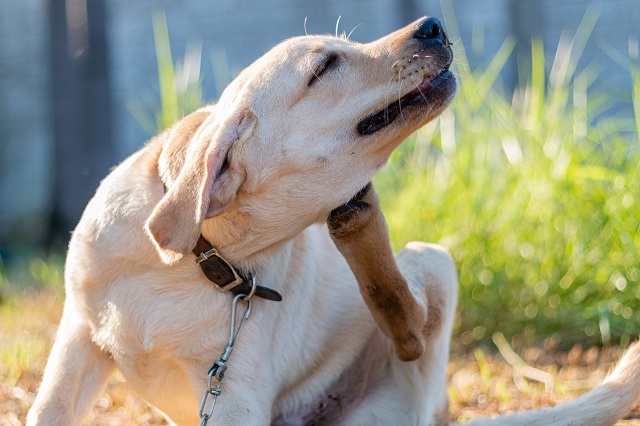Yes, Benadryl can be administered to your Labrador. Benadryl is recommended by most vets for dogs suffering from a variety of ailments. Medications like Benadryl can help with motion sickness, autoimmune and allergic reactions from bug bites, and seasonal allergies.
Labradors with mild to moderate anxiety disorders are often given Benadryl for its sleep-inducing properties. Many Lab owners give Benadryl to their dogs at times of high stress, such as in the case of severe storms or fireworks.
You can purchase Benadryl over-the-counter, and it is a brand-name antihistamine. In addition to treating seasonal allergies and other allergies, it helps treat the common cold, skin irritation resulting from insect bites, hives, and other causes.
When to use Benadryl with your Labrador
To help with allergies:
Your Labrador may feel more comfortable with Benadryl when he/she is experiencing an allergic reaction. Several factors can cause runny noses and watery eyes, so it may also help with this problem.
| Runny or stuffy nose | Hives |
| Sneezing | Watery eyes |
| Red, itchy, or dry eyes | Excessive itchiness |
| Swelling | Redness and inflammation |
To help with motion sickness:
Diphenhydramine, the active ingredient in Benadryl, is very similar to Dramamine. Dogs can also take Dramamine, an over-the-counter medication for travel sickness. Benadryl can help your Lab cope with motion sickness caused by automobile motion because of the similarity between the two medications.
| Excessive drooling | Diarrhea |
| Repetitive swallowing | Restlessness |
| Compulsive licking | Trembling |
| Vomiting | Whining |
To help with anxiety:
Additionally, Benadryl can be very beneficial for situations that cause anxiety. Anxiety caused by a situation or circumstance that your lab has faced is known as situational anxiety. These are some of the most common reasons for your Labrador to experience situational anxiety:
- Fireworks
- Thunderstorms
- Travel
- Unfamiliar or unusual visitors
- Noises, especially loud noises like construction
| Trembling or shivering | Tail tucked between legs |
| Diarrhea | Hiding |
| Compulsive licking or other behaviors | Refusing to engage or take part in activities |
How much Benadryl should I give my Labrador?
To give Benadryl to your Labrador, you should always weigh them. In general, however, a Labrador should weigh between 70 and 80 pounds / 36 kilograms and under.
It is recommended to give dogs 1 mg of Benadryl per pound of body weight, 2-3 times daily. The most common diphenhydramine tablet size is 25 mg.
For the correct dosage, however, you should consult your veterinarian. In addition, many products contain other medications, such as paracetamol, so be sure Benadryl tablets contain diphenhydramine.

Are there any side effects?
Dogs usually have no problems with Benadryl. However, if they are also taking other medications at the same time, they may have an allergic reaction. Speak with your veterinarian before administering this medication.
It is possible for this medication to cause side effects. You should always keep an eye out for any unexpected side effects when taking Benadryl. Serious side effects are rare. Here are some of the most common side effects:
| Dry mouth | Changes in appetite |
| Faster heart rate | Excessive drooling |
| Sleepiness | Panting or faster breathing. |
| Diarrhea | Vomiting or nausea |
Conclusion
When Labradors are suffering from allergies, situational anxiety, or sickness, Benadryl can be an excellent treatment. Low-cost, convenient diphenhydramine is useful for treating a variety of ailments.
Regardless, make sure that your pet’s wellbeing is always a priority.
Care should always be taken when administering medications. Seek advice from your veterinarian if you are unsure about your Labrador’s condition. A veterinarian is the best person to consult if you are unsure whether Benadryl is the right choice for you.

